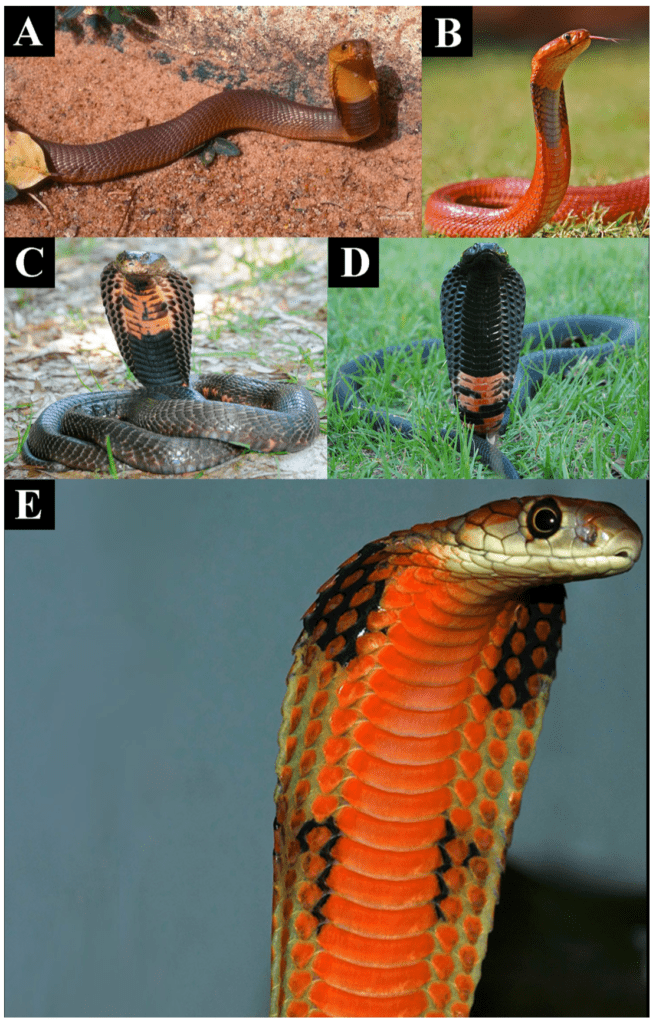Cobras are some of the most dangerous snakes in the world, causing crippling losses in Africa and Asia. Even for survivors, amputation is often necessary due to the snake’s flesh-eating venom. But why, and how did they evolve this venom?

Associate Professor Bryan Fry of UQ’s School of Biological Sciences wanted to get to the bottom of this extremely dangerous mystery, so they analyzed 29 cobra species and related snakes, finding that the flesh-destroying venom evolved side by side the distinctive broad hoods that make the cobras extra terrifying.
“While we knew the results of their venom, how the cobra’s unique defensive venom evolved remained a mystery until now,” he said. “Our study discovered the evolutionary factors shaping not only cobra venom, but also the ornate markings on their hoods, and the extremely bright warning colourings present in some species.”
Overall, there are over 270 cobra species spread throughout Africa and Asia, and they exact a terrible toll on both human and animal victims. Their venom — which by the way isn’t only delivered by biting, but also by spitting — causes extreme pain, blindness, respiratory failure, possible amputation of limbs, and can very easily kill you. Scientists are very well aware of the flesh eating properties, but did it evolve as an offensive or as a defensive mechanism?
Fry found that as the cobras developed this type of venom, their hoods started to change — warning off potential predators with hood markings, body banding, red colouring and spitting. So they developed an extra-dangerous venom, and they did their best to make sure everyone knows. The more ornate the cobra, the more dangerous the venom.
“Their spectacular hoods and eye-catching patterns evolved to warn off potential predators because unlike other snakes, which use their venom purely for predation, cobras also use it in defence,” he said. “For the longest time it was thought that only spitting cobras had these defensive toxins in high amounts in their venoms, however we’ve shown that they are widespread in cobras. These results show the fundamental importance of studying basic evolution and how it relates to human health.”

Credit: Courtesy Associate Professor Fry
So the potency of the venom developed as a defensive mechanism, but even more interestingly, it developed twice, independently. The first time, in “true” cobras, and then secondly, in king cobras — despite the world ‘cobra’ in their name and despite being the largest venomous snake in the world, king cobras are not real cobras, but they evolved the same mechanism, both for the venom and for the hood.
Now, the next step for researchers is to perform tests on antivenom, to better understand how it can be improved. Because most snakebites occur in developing parts of the world, producers have been reluctant to enter the market, or have left it altogether. Antivenom production in general is underdeveloped.
“Globally, snakebite is the most neglected of all tropical diseases and antivenom manufacturers are leaving the market in favour of products that are cheaper to produce and have a bigger market,” he said. “Antivenom is expensive to make, has a short shelf life and a small market located in developing countries. Therefore, we need to do further research to see how well those remaining antivenoms neutralise not only the toxins that kill a person, but also those that would cause a severe injury.”
Also encouraging is the fact that this type of antivenom could be used in treating some cancers. Because the venom only attacks some tissues and leaves others unharmed, it might be “trained” to only attack cancerous cells. In the end, the devastating venom of the cobra could hold a much-needed cure.
“Any kind of compound that selectively kills cells could be a good thing,” Dr Fry said. “These chemicals may lead to new cancer treatments if we can find ones that are more potent to cancer cells than normal healthy cells. Cobras are a rich resource of novel compounds in this way so there may ultimately be a silver lining to this very dark cloud.”
Journal ref: Nadya Panagides et al. How the Cobra Got Its Flesh-Eating Venom: Cytotoxicity as a Defensive Innovation and Its Co-Evolution with Hooding, Aposematic Marking, and Spitting, Toxins (2017). DOI: 10.3390/toxins9030103
Was this helpful?



